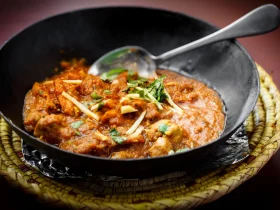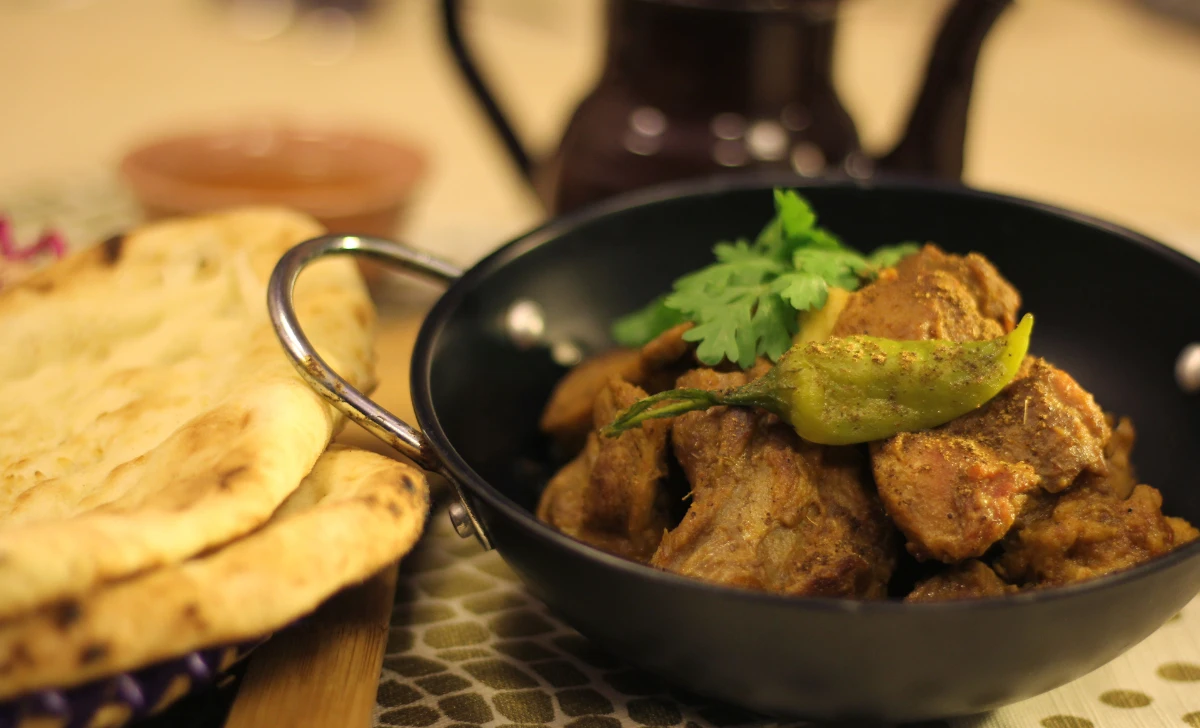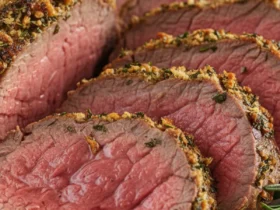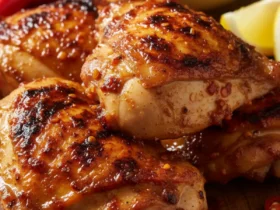If you’re a true food enthusiast who revels in the rich tapestry of flavors, then look no further. We’re about to embark on a culinary journey that will tantalize your taste buds and transport you to the heart of Pakistani cuisine. Get ready to master the art of crafting an irresistible Mutton Karahi that bursts with aromatic spices and tender meat. Whether you’re a seasoned chef or a kitchen newbie, this recipe will have you cooking up a storm in no time.
[ez-toc]
History
Every dish has a story to tell, and the history of Mutton Karahi is a flavorful journey that takes us back to the heart of Pakistani cuisine. This iconic dish didn’t just emerge overnight; it’s a culmination of cultural influences, regional traditions, and a deep-rooted love for food. Let’s travel through time and unveil the tale behind the sizzling karahi.
Early Roots and Cultural Fusion
The story of Mutton Karahi begins in the ancient kitchens of the Indian subcontinent. Centuries ago, the art of cooking in a karahi was embraced by different communities living in the region. The word “karahi” itself is derived from the Urdu language, referring to the deep, wide-mouthed, and rounded cooking vessel used to prepare the dish.
In a land known for its diverse cultures, the karahi became a canvas for culinary creativity. The melding of indigenous spices and cooking techniques with Persian influences led to the birth of what we now know as Mutton Karahi. The intricate use of spices, bold flavors, and tender meat quickly made it a cherished dish in the royal courts.
From Rustic Kitchens to Modern Tables
The transition from royal feasts to common households is a testament to the enduring appeal of Mutton Karahi. As Pakistan came into existence in 1947, the dish began to take on a more significant role in the nation’s culinary identity. The karahi became a symbol of shared meals, family gatherings, and celebrations.
What truly distinguishes Mutton Karahi is its preparation technique. The traditional iron karahi, often passed down through generations, adds a depth of flavor and character that modern cookware can’t replicate. This connection to the past is a key element in preserving the dish’s authenticity.
Regional Variations and Local Flavors
As Pakistan’s provinces embraced their unique culinary traditions, Mutton Karahi evolved into a dish with distinct regional variations. In the Punjab region, the dish is known for its robust and spicy flavors, while Sindh offers a milder version with a harmonious blend of spices. Balochistan and Khyber Pakhtunkhwa bring their flair to the karahi, infusing it with local herbs and ingredients.
The dish’s popularity also transcended borders, reaching beyond Pakistan’s boundaries to captivate the taste buds of food enthusiasts worldwide. Restaurants and eateries around the globe now proudly feature Mutton Karahi on their menus, introducing a global audience to the magic of Pakistani flavors.
A Dish of Togetherness and Celebration
What truly sets Mutton Karahi apart is its ability to create an atmosphere of togetherness and celebration. Picture a bustling kitchen, the aroma of spices mingling with laughter, and a sizzling karahi at the center of it all. Whether it’s a festive occasion, a casual dinner, or an impromptu gathering, Mutton Karahi brings people together to share not just a meal, but an experience.
Preserving Tradition in Modern Times
In an era of fast-paced living and evolving tastes, Mutton Karahi remains a steadfast symbol of tradition and heritage. Families continue to pass down recipes and techniques from one generation to the next, ensuring that the essence of this dish endures.
As you embark on your culinary adventure to create the perfect Mutton Karahi, remember that you’re not just cooking a meal; you’re keeping alive a legacy that spans centuries. So, savor every moment, embrace the flavors, and let the history of this iconic dish infuse your kitchen with warmth and nostalgia.
Time
| Step | Time |
|---|---|
| Preparing the Mutton Marinade | 15 minutes |
| Sautéing Onions and Tomatoes | 20 minutes |
| Adding the Magic Spice Blend | 5 minutes |
| Simmering and Letting the Flavors Dance | 40 minutes |
| Total Cooking Time | 1 hour 20 mins |
Ingredients
| Ingredients | Quantity |
|---|---|
| Bone-in Mutton (shoulder or leg) | 250 grams |
| Yogurt | 1/4 cup |
| Ginger (finely chopped) | 1 tablespoon |
| Garlic (minced) | 1 tablespoon |
| Turmeric powder | 1/2 teaspoon |
| Salt | To taste |
| Onions (sliced) | 1 medium |
| Tomatoes (chopped) | 2 medium |
| Green Chilies (sliced) | 2 |
| Red Chili Flakes | 1/2 teaspoon |
| Coriander Powder | 1 teaspoon |
| Cumin Powder | 1/2 teaspoon |
| Garam Masala | 1/2 teaspoon |
| Fresh Coriander Leaves | For garnishing |
| Fresh Lemon Juice | 1 tablespoon |
| Cooking Oil | 3 tablespoons |
| Naan or Roti | For serving |
Please note that these quantities are for a 2-person serving. Adjust as needed based on your preferences and appetite.
Directions
Step 1: Preparing the Mutton Marinade
Ingredients:
- Bone-in Mutton (shoulder or leg), 250 grams
- Yogurt, 1/4 cup
- Ginger (finely chopped), 1 tablespoon
- Garlic (minced), 1 tablespoon
- Turmeric powder, 1/2 teaspoon
- Salt, to taste
- In a mixing bowl, combine the yogurt, finely chopped ginger, minced garlic, turmeric powder, and a pinch of salt.
- Add the bone-in mutton to the marinade, ensuring each piece is well-coated. Allow it to marinate for at least 30 minutes, or ideally, refrigerate it for a couple of hours to let the flavors meld.
Step 2: Sautéing Onions and Tomatoes
Ingredients:
- Onions (sliced), 1 medium
- Tomatoes (chopped), 2 medium
- Green Chilies (sliced), 2
- Cooking Oil, 3 tablespoons
- Heat the cooking oil in a karahi or heavy-bottomed skillet over medium heat.
- Add the sliced onions and sauté until they turn golden brown and caramelized. This might take about 10-12 minutes.
- Incorporate the chopped tomatoes and green chilies, and cook until the tomatoes break down and form a luscious base. Stir occasionally to prevent sticking.
Step 3: Adding the Magic Spice Blend
Ingredients:
- Red Chili Flakes, 1/2 teaspoon
- Coriander Powder, 1 teaspoon
- Cumin Powder, 1/2 teaspoon
- Garam Masala, 1/2 teaspoon
- Sprinkle the red chili flakes, coriander powder, cumin powder, and garam masala over the sautéed mixture.
- Mix well to distribute the spices evenly, letting their captivating aroma infuse the dish.
Step 4: Simmering and Letting the Flavors Dance
Ingredients:
- Fresh Coriander Leaves, for garnishing
- Fresh Lemon Juice, 1 tablespoon
- Gently add the marinated mutton to the karahi, nestling it within the aromatic mixture.
- Lower the heat to a gentle simmer, cover the karahi, and let it cook for about 30-40 minutes. This slow cooking allows the flavors to intensify and the mutton to become tender.
- During the last few minutes of cooking, sprinkle fresh coriander leaves and drizzle fresh lemon juice to enhance the freshness of the dish.
- Serve the Mutton Karahi hot with naan or roti and relish the symphony of flavors you’ve created.
With each step, you’re crafting an exquisite Mutton Karahi that’s sure to delight your senses and transport you to the heart of Pakistani cuisine. Enjoy the process, embrace the aromas, and savor every bite of this culinary masterpiece.
Equipment Required
Nutrition Information
| Nutrition Information | Per Serving |
|---|---|
| Serving Size | 1 person |
| Calories | 350 kcal |
| Total Fat | 25g |
| – Saturated Fat | 8g |
| Cholesterol | 80mg |
| Sodium | 600mg |
| Total Carbohydrates | 8g |
| – Dietary Fiber | 2g |
| – Sugars | 3g |
| Protein | 25g |
Please note that these values are approximate and can vary based on factors such as ingredient brands and specific preparation methods.
Tips
- Choose the Right Cut: Opt for bone-in mutton, such as shoulder or leg, for richer flavors and tender meat that’s perfect for slow cooking.
- Marination Magic: Allow the mutton to marinate for a few hours, or even overnight, for deeper flavors and enhanced tenderness.
- Slow and Steady: Take your time while sautéing onions and tomatoes. Slow-cooked onions create a sweet and caramelized base for your karahi.
- Heat Control: Adjust the number of green chilies and red chili flakes to suit your spice tolerance. Balancing heat and flavor is key.
- Spice Blending: Use freshly ground spices for the best results. The aroma and taste will be truly exceptional.
- Simmer with Care: Low and slow simmering allows the flavors to develop and the mutton to become succulent. Avoid rushing this step.
- A Touch of Acid: A squeeze of fresh lemon juice adds a delightful tang that balances the richness of the dish.
Pros & Cons
| Pros | Cons |
|---|---|
| ✔️ Bursting with Rich Flavors | ❌ Longer Cooking Time |
| ✔️ Represents Pakistani Culinary Heritage | ❌ Requires Marination Time |
| ✔️ Aromatic and Spicy Delight | ❌ High in Saturated Fat |
| ✔️ Perfect for Special Occasions | ❌ Not Suitable for Vegetarians |
| ✔️ Offers a Wholesome Meal | ❌ May Be Too Spicy for Some |
Conclusion
Congratulations, fellow food lover, you’ve embarked on a journey that leads straight to the heart of Pakistani cuisine with our delectable Mutton Karahi recipe. With every aromatic spice and tender bite, you’re immersing yourself in a tradition that’s as rich as the flavors it offers. This dish isn’t just a recipe; it’s an experience that connects generations, cultures, and taste buds.
As you stand by the stove, sautéing onions to caramelized perfection and coaxing the mutton to tender succulence, you’re not just cooking a meal. You’re weaving a story, a narrative of love for flavors, togetherness, and the magic that happens when ingredients dance in a sizzling karahi. The aroma that fills your kitchen is the scent of tradition and the promise of an unforgettable feast.
So, whether you’re sharing this dish with family and friends, or treating yourself to a moment of culinary triumph, remember that Mutton Karahi isn’t just a recipe; it’s a celebration of life’s simple pleasures. Embrace the sizzle, embrace the taste, and create memories that linger far beyond the last bite. Don’t just read about it – dive into your kitchen, pick up that karahi, and let the culinary magic begin. Your taste buds will thank you, and your heart will surely sing with delight. Happy cooking! 🍽️👨🍳👩🍳
Facts
- 🔥 Fact 1: The Sizzle Story of the Karahi 🔥
- Did you know that the karahi, the iconic cooking vessel for Mutton Karahi, has a history as vibrant as the flavors it creates? Originating from Central Asia, it made its way to the Indian subcontinent through the spice trade routes. The karahi’s unique shape and material make it perfect for even cooking and that tantalizing caramelization we love.
- 🌶️ Fact 2: The Spicy Chemistry Experiment 🌶️
- Spices aren’t just flavor enhancers; they’re chemistry in action! When you mix ground cardamom, cloves, and cinnamon, you’re creating a symphony of taste and aroma. Each spice brings its personality to the dish, mingling with the mutton to create a flavor profile that’s nothing short of magic.
- 🎉 Fact 3: Karahi – More Than a Pan 🎉
- The karahi isn’t just a cooking utensil; it’s a cultural symbol. In Pakistan, it’s more than a pan; it’s a centerpiece that gathers loved ones. Picture a sizzling karahi in the middle of a family table, and you’ve got the heart of every celebration. It’s the embodiment of togetherness and culinary joy.
- 🍴 Fact 4: A Dish of Regional Diversity 🍴
- Mutton Karahi is a dish that unites, but it also celebrates regional diversity. As you move across Pakistan’s provinces, you’ll find variations that pay homage to local ingredients and traditions. From fiery Punjabi flavors to the subtle spices of Sindh, this dish tells the tale of a nation’s culinary tapestry.
- 🌍 Fact 5: From Kitchens to Global Plates 🌍
- What started as a humble dish in Pakistani kitchens has journeyed far beyond borders. Thanks to its irresistible flavors, Mutton Karahi has found its way onto menus around the world. Whether you’re in Lahore or London, you can savor the taste of Pakistan’s culinary heritage and appreciate its universal appeal.
FAQ’s
What is Mutton Karahi?
Mutton Karahi, also known as Karahi Gosht, is a traditional Pakistani dish featuring bone-in mutton pieces cooked in a karahi, a deep, wide-mouthed cooking vessel. It’s flavored with aromatic spices, onions, tomatoes, and green chilies, resulting in a flavorful and hearty curry.
Can I use a different type of meat?
Absolutely! While the recipe traditionally uses mutton, you can substitute it with bone-in chicken, beef, or even seafood like shrimp. Adjust cooking times accordingly for different meats.
How long does it take to cook Mutton Karahi?
The cooking time varies based on the size and tenderness of the mutton. On average, it takes about 1 hour 20 minutes, including marination and simmering.
Is Mutton Karahi spicy?
The level of spiciness can be adjusted to your preference. While the recipe includes green chilies and red chili flakes, you can reduce or increase the amount to suit your taste.
Can I make this dish in advance?
Absolutely! In fact, Mutton Karahi often tastes even better the next day as the flavors continue to meld. Simply reheat it gently on the stovetop.
What can I serve with Mutton Karahi?
Mutton Karahi pairs wonderfully with naan, roti, or even saffron rice. You can also serve it with a cooling raita and a fresh salad for a complete meal.
Can I make this recipe in a regular skillet?
Yes, you can use a heavy-bottomed skillet if you don’t have a traditional karahi. While the smoky essence from the seasoned karahi might be missed, the flavors will still be delicious.
How can I make the dish less spicy?
To make Mutton Karahi less spicy, reduce the amount of green chilies and red chili flakes. You can also omit the red chili flakes altogether if you prefer a milder flavor.
Can I add vegetables to the dish?
Absolutely! Bell peppers, tomatoes, and even potatoes can be added to the karahi for additional flavors and textures. Just adjust cooking times accordingly.
Can I freeze leftover Mutton Karahi?
Yes, you can freeze leftover Mutton Karahi. Portion it into airtight containers and label them with the date. When reheating, gently thaw and warm on the stovetop.












Leave a Review